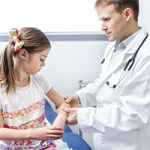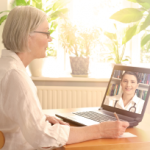How are pediatric rheumatologists and the care they deliver to their patients—many of whom are 5 years old or younger—affected by physical distancing precautions related to COVID-19? The Rheumatologist interviewed Sangeeta Sule, MD, PhD, chief, Division of Rheumatology at Children’s National Hospital and associate professor of pediatrics at The George Washington University School of Medicine and Health Sciences, Washington, D.C., to discuss how the pandemic has changed the way she and her colleagues interact with patients, parents and each other.
Q: How are you and your staff adapting to the changes brought about by the COVID-19 pandemic?
These are challenging times. For all of us, there is a common feeling of isolation. We’re so used to coming in to the office and having personal and professional conversations. So recently we started a weekly Zoom check-in, [during which] we all turn on our videos and meet virtually. This [practice] has been a wonderful way to discuss and share. Hopefully, at some point in the future, we will be able to see each other again in person.
Children who need infusions are still able to get them. As the pandemic began moving through the U.S., we switched some infusion patients to home infusions or subcutaneous injections when possible. Some procedures are amendable to home therapy, and some are not because of infection risks. For our patients, it’s critical to have pediatric-trained nurses, because putting an IV in the vein of a 2-year-old is different from putting one into the vein of a 40-year-old.
Q: Could you tell us about how your clinic is using technology to adapt to the need for physical distancing, such as telemedicine?
We started doing telemedicine visits [in] March, and it has been going well. Some parents are worried about bringing their immunocompromised child into clinic, so telemedicine visits are a great alternative, and parents love it. We still have in-person visits for children who need to be seen in clinic and use appropriate precautions if the child has symptoms suggestive of COVID-19.
The hardest part for me is that I miss human interaction. Our patients are young, so we are always giving them hugs, high-fiving or telling them they’re doing great, and that part is missing with telemedicine. Children are resilient and may not complain or say they’re in pain, so we rely on our physical exam. It’s challenging to perform a joint exam and tell if a joint is swollen because we have to feel the involved area. Also, since I’ve been doing telemedicine, I’ve met a lot of people’s dogs that wander into the visit. It’s a little bit of chaos all the time.
Q: What are you telling patients or parents about the potential risks of COVID-19 or symptoms to watch for? What are their chief concerns, including access to care for medications?
From a parent’s or teenage patient’s point of view, the fact that they’re on immunosuppressant drugs to control their disease makes them scared right now. Parents are worried that if they go outside to run errands, such as a trip to the grocery store, they will bring disease back into their homes. There’s a lot of fear and uncertainty. What we have been telling people is that if your child has a fever, body aches, loss of taste or smell, cough, or any respiratory or gastrointestinal distress, call your doctor to discuss immediately.
Access to medications is also a concern. When all the press came out about hydroxychloroquine, we started getting a lot of calls from families that pharmacies were having shortages of the drug. Children with lupus could only get a one to two-week supply at a time. Another big worry is that this type of shortage could happen with biologics, such as tocilizumab and others being studied as possible COVID-19 treatments. Also, I had a parent tell me the alcohol swabs they use to clean the skin prior to weekly methotrexate injections was out of stock at many stores. We have been encouraging families to fill their prescriptions in a timely manner to avoid running out of medications.
Q: How are the pandemic and social distancing affecting you and your family personally?
During these times, all of us have to adjust to a new normal. I am planning my shopping in advance to reduce the number of outings. I am also doing more shopping online and conserving the supplies I have.
Susan Bernstein is a freelance journalist based in Atlanta.




